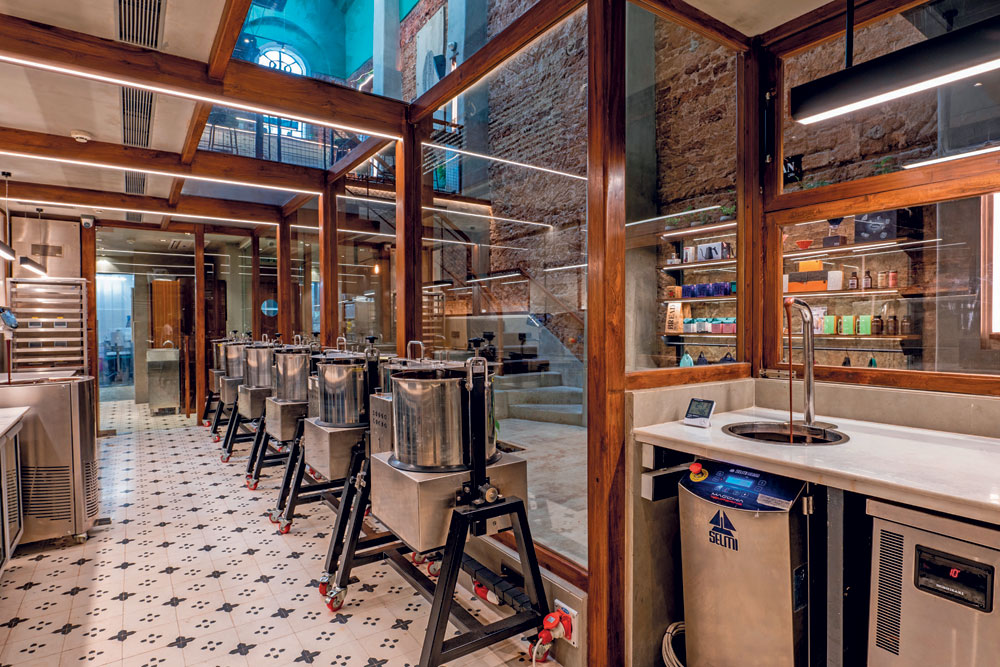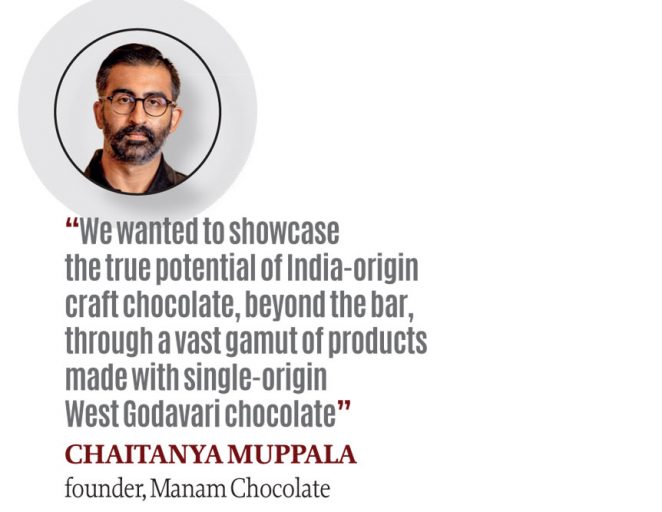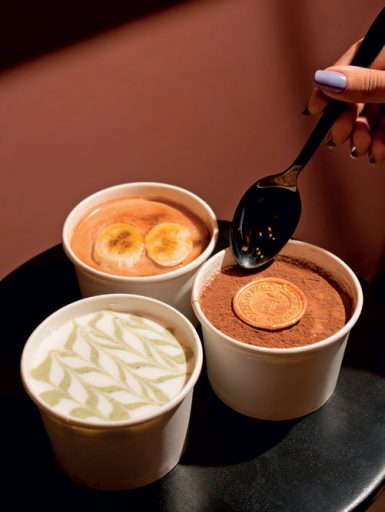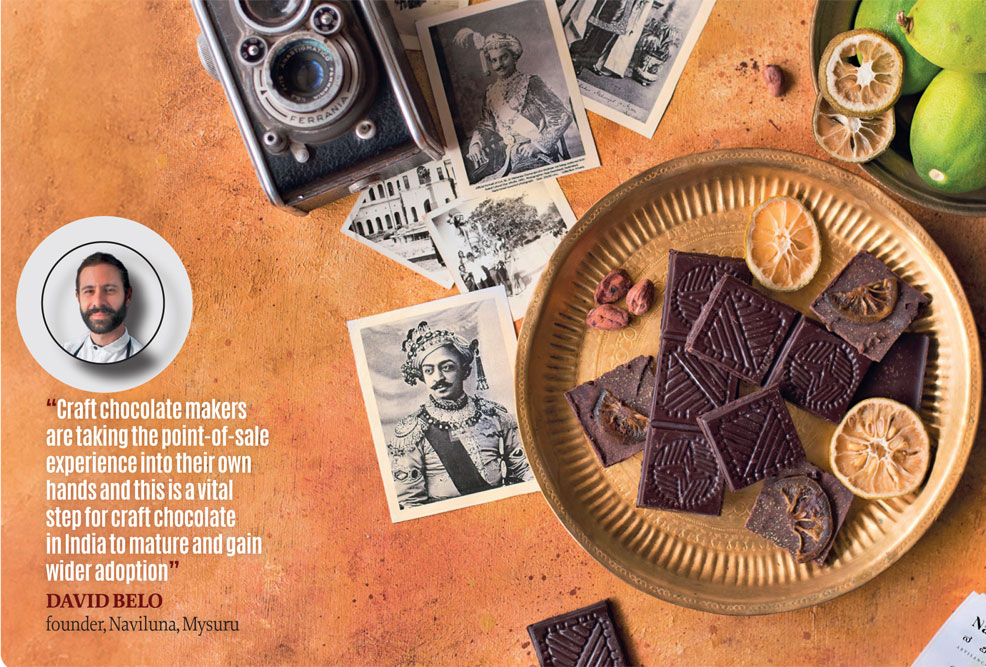Chocolate Chic
A new gourmet trend comes to the cities
 Priyadarshini Chatterjee
Priyadarshini Chatterjee
 Priyadarshini Chatterjee
Priyadarshini Chatterjee
 |
20 Oct, 2023
|
20 Oct, 2023
/wp-content/uploads/2023/10/Chocolate1.jpg)
Recently, Manam, a new craft chocolate brand opened doors to its luxurious flagship location, the Manam Karkhana, on a buzzing stretch of Hyderabad’s posh Banjara Hills. The brainchild of 32-year-old Chaitanya Muppala, whose family owns Hyderabad’s feted sweet shop chain Almond House, the Manam Karkhana is a microcosm of India’s changing craft chocolate universe.
The sprawling 10,100-square-feet experience centre packs in a massive retail section chockfull with chocolates in myriad avatars, which leads to the eponymous karkhana or chocolate factory, complete with a tech-enabled roastery, and dedicated stations for cracking and winnowing cacao beans, and grinding, refining and conching (polishing) chocolate. Finally, there’s the tempering zone and the chocolaterie where chocolatier Ruby Islam and her team turn out magical confections with Manam’s craft chocolate. Guests can walk through the various stages of making chocolate, albeit from behind a glass wall furnished with decals explaining the different processes.
The space also packs in a courtyard cafe built around a cacao tree brought in from one of the farms in West Godavari district that Manam sources its cacao beans from. Besides, there’s the Manam classroom where plans are afoot to host workshops and tasting sessions to enable a deeper exploration and understanding of Indian-origin craft chocolate.
The craft chocolate movement in India has gradually but resolutely gained pace over the last decade. Even though India has been growing cacao since the 1960s, it’s been predominantly for industrial use where the beans are mass processed to achieve a standardised flavour devoid of nuance. It is only relatively recently that chocolate makers have taken up the task to nudge the best possible flavours from the cacao beans and create high quality, fine-flavoured chocolate in small batches.

Layered with history, legends and cultural memories—chocolate is an experience beyond being a sweet treat. And more and more craft chocolate makers in India are harnessing its inherent experientiality to craft fine-flavoured Indian cacao and facilitate deeper engagement with chocolate through exciting experiential spaces—from chocolate factories to tasting rooms and studios.
Earlier this year Subko Cacao, an arm of Mumbai-based Subko Specialty Coffee Roasters, launched The Cacao Mill by Subko. Tucked in a narrow lane off Colaba Causeway, the 2,000-square feet space was originally occupied by a textile mill, followed by an art gallery and CrossFit gym, before it was repurposed as Subko’s chocolate factory. Spread over two floors, the Cacao Mill packs in a glass-walled chocolate factory, a temperature-controlled zone called The Cellar, which showcases the entire range of Subko Cacao offerings, a merchandising station and cafe (on the mezzanine floor) laid out around an island counter that showcases an impressive selection of Subko’s signature craft bakes. “The pillars of Subko’s philosophy are traceability, showcasing produce from the Indian subcontinent and Asia, at large, integrity, communicating with customers where their product comes from so people are made more aware. Since we are trying to tie into the origin of cacao and farmer-level processing, it is imperative that people understand that journey and experience it in some way. Hence, the need for an experiential space like this,” says Manali Khandelwal, director of Subko Cacao.
Vikas Temani, owner of award-winning Kerala-based craft chocolate brand Paul and Mike, echoes Khandelwal’s view. “A physical space helps better engage with the consumer and give them a better insight into the world of craft chocolate, so they know exactly what they are paying that extra money for,” he says. In June, Paul and Mike opened their first pocket-sized café—aptly termed a micro café—in Mumbai’s Kemps Corner. “We had planned a larger space in Kochi when we started out in 2019 but Covid threw a spanner in the works,” he says.

In Chandigarh, entrepreneurs and brewery owners Priyanka Gupta and Amritanshu Agrawal recently launched their craft chocolate factory Mozimo. The duo that owns three microbreweries (they have been in the business since 2010), decided to venture into the business of crafting chocolate, inspired by their encounters with chocolate-making in Europe. “We wanted to bring the finest handcrafted chocolate to this part of the country,” says Gupta who not only imported the machinery from Italy but also invited an Italian chocolatier on board to train her team. The 1,200-square feet space in Chandigarh’s sector-9 packs in a chocolate factory, a separate section for tempering and panning, an ageing room and a retail area.
Mysuru-based craft chocolate maker David Belo asserts, “I think I can speak for all of us when I say we’re exhausted seeing our bars stuffed into a store shelf by apathetic merchandisers, after having laboured three, five or even 10 days to put that chocolate bar out in the market, never mind all the work that goes into product development, machinery R&D, brand building etc. Craft chocolate makers are taking the point-of-sale experience into their own hands and this is a vital step for craft chocolate in India to mature and gain wider adoption.”
Belo, one of the pioneers of craft chocolate in India, launched his craft chocolate label Naviluna (previously Earth Loaf) in 2012 in Mysuru. A few years ago, he took up the task of restoring a heritage building in the city, the 151-year-old Raghava Sadhana mansion, with its grand late British baroque façade, where Naviluna is currently headquartered. The building covers a carpet area of 4,500-square feet and houses their chocolate production from bean to bar and a chocolate factory, which has been running since last September. Says Belo, “The idea behind what would eventually become Naviluna was to build a product imbued with old-world craftsmanship brought to the market through a brand that emphasised quality, creativity and a tangible origin story. We needed a space that conveyed that origin story and what the product stands for,” he adds.

Origin is the soul of Manam, and cacao is a living protagonist and a recurring motif—be it in its ethos, product or even design. “From cacao pods in pop colours that could have jumped out of an Andy Warhol painting, hand-chipped cacao beans indentations on counter fronts to hand-cast floor tiles that are evocative of the floor of cacao farms strewn with leaves of the cacao tree—everything is a nod to cacao,” says Aarushi Kalra, creative director of I’mX a ranch of I’m D’sign, the design firm behind Manam’s ingenious space.
At Manam, the cacao beans come from designated farms and estates from the fertile West Godavari region through its sister concern Distinct Origins, which works closely with cacao farmers to craft fine-flavoured cacao beans. The beans are then fermented using the box fermentation method and slow-dried on specially designed retractable racks at Distinct Origin’s massive tech-enabled, state-of-the-art fermentery in Tadikalapudi, Andhra Pradesh.
At Subko too the cacao pod is ubiquitous—be it the education board that illustrates the journey of cacao, the installation of a bean cutter or the hand-drawn illustrations of the dissected bean by artist Anu Singh. A cacao sapling has been planted, and a massive projection screne cues back to the origin story of the cacao. There’s also an experiential table that hosts chocolate tasting sessions, aided by a wall-mounted chocolate flavour wheel. Even at the Paul and Mike cafe, despite the space crunch, you can spot attempts at turning the spotlight to the origin of chocolate, in the photographs of different stages of growing and processing cacao. They also host blind-tasting sessions for chocolate enthusiasts, but only in small numbers.

Craft chocolate celebrates origin and terroir. And this philosophy not only inspires the sourcing of other ingredients used in the chocolate created by these brands, but also in the design of these spaces. At Manam, for instance, the cafe area uses vintage tiles sourced from the West Godavari region that are a call back to the origins of Manam’s cacao. Belo, on the other hand, says, “In terms of materiality I’ve tried to be as true to ‘origin’ as possible (just like our chocolate). I’ve used a lot of Mangalore terracotta, Kadapa (black stone from Andhra Pradesh), marble from Rajasthan, Burmese teak, Athangudi tiles made in Bangalore, local granite and ceramics from Gujarat.”
For a long time, craft chocolate has mostly been synonymous with bars simply because they are sturdier and easier to transport (to shopfronts) and have a longer shelf life. But with the rise of such experiential spaces—the edible experience of craft chocolate will also expand, says Temani. Paul and Mike, who had for a long time mostly restricted their superlative offerings to chocolate bars, now has a larger repertoire of products. At their Mumbai café, chocolatier Omkar Dabhane has developed a crisp but small selection of bakes and confections made from their craft chocolate. At Subko Cacao Mill their craft chocolate is used in their craft bakes. In addition to their single-origin terroir range, there’s a variety of filled bars, and big and small cubes with gourmet centres to quirky variants of hot chocolate, including one spiked with mulagapodi (or gunpowder).
However, it is at the Manam Karkhana that one is bowled over by the variety. At Manam, the idea is to “overwhelm through plenty-ness, a sense of abundance.” “We wanted to showcase the true potential of India-origin craft chocolate, beyond the bar, through a vast gamut of products made with single-origin West Godavari chocolate” says Muppala. The result is a bouquet of Indian craft chocolate products spanning over 250 concepts across 45 categories—from several types of their signature tablets, including their creative fermentation range of tablets crafted with cacao that’s been fermented with unique native ingredients, such as mango-ginger.
One of the highlights of the Manam experience is the chocolate lab where one can create one’s own chocolate slab. Take your pick of chocolate—dark, milk or white—that flow out of taps, and choose your inclusions—caramel-laced almonds or freeze-dried raspberry nibs or sea-salt flecked apricot gel. The bespoke chocolate tablets are fed into the system, and you can order it as you want.

Subko, on the other hand offers a pod-to-bar experience board that takes you on an edible journey through the different stages of crafting chocolate and exploring the various flavours and textures cacao produces.
The experience of chocolate also extends to the packaging. Subko’s terroir range uses rustic craft paper in brown and black, jazzed up with gold foil accent, to give it a more formal appearance, while the packaging for their filled bars, some of which are inspired by nostalgia-laced classic candy bars like Twix and Snickers, come in fun, pop colour packaging. “Even the butter paper is creased, cut and curated especially for us,” says Khandelwal.
Manam is quintessentially a farmer-forward brand and storytelling is crucial to the Manam experience. Here the chocolates themselves turn storytellers. The packaging comes with a QR code that can be scanned to trace the chocolate back to its origins—details about the farm it comes from and the farmer behind it, its terroir and other such crucial information that enable consumers to better appreciate its journey. Cacao farmers are in fact at the heart of Manam and have a palpable presence at the Karkhana, be it in life-sized murals or miniature models of cacao farmers.
Muppala is focused on his vision of taking Indian origin cacao to the world. “The craft chocolate movement is fairly nascent globally,” he points out. “So, India has an advantage—an opportunity to lead from the front, especially because India grows its own cacao. Cacao doesn’t grow in Belgium,” he adds.
Belo predicts that the kind of venture capital that has slid into coffee, beer and spirits will find its way into chocolate. This will ensure the creation of big stores with passionate staff detailing the benefits of craft chocolate. “On the whole, I predict it’ll be a net win for craft chocolate as we need that sort of scale to enter the imagination of the general public, and for a few shining stars to emerge,” he says.

/wp-content/uploads/2025/06/Cover-OpenMinds2025.jpg)










More Columns
Puri Marks Sixth Major Stampede of The Year Open
Under the sunlit skies, in the city of Copernicus Sabin Iqbal
EC uploads Bihar’s 2003 electoral roll to ease document submission Open